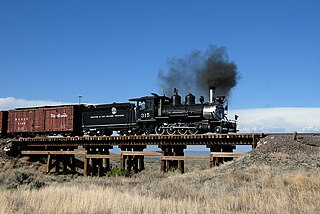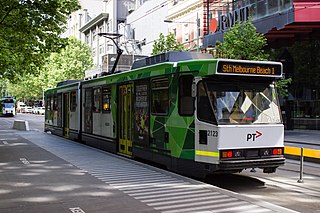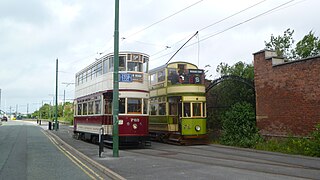
The Portland Cable Tram is heritage tramway in Portland, Victoria, Australia. It opened on 2 March 2002. Although the rolling stock in use are replicas or restored models of cable trams, they now run with diesel motors.

The Portland Cable Tram is heritage tramway in Portland, Victoria, Australia. It opened on 2 March 2002. Although the rolling stock in use are replicas or restored models of cable trams, they now run with diesel motors.
Portland Cable Tram Line | |||||||||||||||||||||||||||||||||||||||||||||||||||||||||||||||||||||||||||||||||||||||||||||||||||||||||||||||||||||||||||||||||||||||||||||||||||||||||||||||||||||||||||||||||||||||||||||||||||||||||||||||||||||||||||||||||||||||||||||||||||||||||||||||||||||||||||||||||
|---|---|---|---|---|---|---|---|---|---|---|---|---|---|---|---|---|---|---|---|---|---|---|---|---|---|---|---|---|---|---|---|---|---|---|---|---|---|---|---|---|---|---|---|---|---|---|---|---|---|---|---|---|---|---|---|---|---|---|---|---|---|---|---|---|---|---|---|---|---|---|---|---|---|---|---|---|---|---|---|---|---|---|---|---|---|---|---|---|---|---|---|---|---|---|---|---|---|---|---|---|---|---|---|---|---|---|---|---|---|---|---|---|---|---|---|---|---|---|---|---|---|---|---|---|---|---|---|---|---|---|---|---|---|---|---|---|---|---|---|---|---|---|---|---|---|---|---|---|---|---|---|---|---|---|---|---|---|---|---|---|---|---|---|---|---|---|---|---|---|---|---|---|---|---|---|---|---|---|---|---|---|---|---|---|---|---|---|---|---|---|---|---|---|---|---|---|---|---|---|---|---|---|---|---|---|---|---|---|---|---|---|---|---|---|---|---|---|---|---|---|---|---|---|---|---|---|---|---|---|---|---|---|---|---|---|---|---|---|---|---|---|---|---|---|---|---|---|---|---|---|---|---|---|---|---|---|---|---|---|---|---|---|---|---|---|---|---|---|---|---|---|---|---|
| |||||||||||||||||||||||||||||||||||||||||||||||||||||||||||||||||||||||||||||||||||||||||||||||||||||||||||||||||||||||||||||||||||||||||||||||||||||||||||||||||||||||||||||||||||||||||||||||||||||||||||||||||||||||||||||||||||||||||||||||||||||||||||||||||||||||||||||||||
In 1996, the Portland Cable Tram project was established with the aim of creating a tramway in the town. The basis of the proposal was that although Portland was in a region with natural tourist attractions, it lacked a significant man-made feature which would encourage tourists to stay longer in the area. [1]
The funding of such a large project initially presented a problem, as tracks would have to be laid, rolling stock acquired, and a storage shed built. However, a donation of $220,000 by the Handbury family helped the proposal gain momentum. This was followed by $500,000 from the Federal Government, $775,000 from the Victorian Government and $175,000 from the Shire of Glenelg. A further $500,000 from other sources brought the total to $2.17 million. [1]
The first year of operation proved successful, with 14,000 passengers carried. [1] Since opening, more than 135,000 people have ridden the Portland Cable Tram. [2]
The Portland Cable Tram is run by a group of around 60 volunteers [2] who undertake roles as tram drivers, conductors, administrators, maintenance workers, cleaners, gardeners, and museum display curators. The tramway's general manager is the only paid employee. [1] [2]
The trams usually run five times a day, but only four services operate daily during winter. The route operates 364 days a year; there are no services on Christmas Day nor in the morning on Anzac Day and Good Friday. [2]
Tickets, which provide one day's unlimited use of the trams, are available from the Museum and Depot, online, or the tram's conductor. Annual tickets are also available. Passengers may board and alight the trams at any of the six stations.
The Portland Cable Tram Museum and Depot is home to an 1880 horse-drawn carriage owned by Edward Henty, the first permanent European settler in the Port Phillip District (later Victoria), as well as model railway exhibits, classic cars and the largest private gemstone collection in the southern hemisphere. The gift shop sells memorabilia and refreshments are also available. [2]
The line is 3.7 kilometres long [1] and journeys depart from and return to the Portland Cable Tram Museum and Depot.
Beginning at the Museum and Depot, the tram heads in a westerly direction, stopping at the Powerhouse Museum, a small institution showcasing motor vehicles. A balloon loop then sends the tram back towards the Museum and Depot station after some street running. Passing through Henty Park, the next stop is the Botanic Gardens after which the line turns north and runs close to the Portland harbour along the Foreshore. A stop at the Portland Maritime Discovery Centre is followed by a climb up the headland to the Portland Bay Holiday Park, where another station is located. After passing several homes, the line turns east to terminate at the World War II Memorial Lookout, which also served as a water tower. At this point, the tram sets are turned on a triangle for the return trip back to the Portland Cable Tram Museum and Depot, making the ride 7.4 kilometres and around one hour in length. [2]
There is a variety of rolling stock currently in use on the tramway.
The two grip cars operated by Portland Cable Trams are copies of Melbourne cable trams which ran from 1885 to 1940, constructed to the specifications of that period. They were built from scratch under the auspices of Keith McMillan, and are exact replicas, apart from the diesel engines that they use in place of the cable system. [2] That method of propulsion was chosen because it would be virtually impossible to build the complicated underground cable network which originally pulled cable trams along. [1]
The two saloon cars in service at Portland did run on the Melbourne system during its heyday. After the electrification of the network, the outdated cable tram cars were sold off. Saloon Car No. 95 initially entered service in November 1886 and was used on the Victoria Street route, running via Collins Street. [1] The Portland Cable Tram organisation salvaged that car from Newton Williams in Swan Hill and restored it to service in February 2002. [1] [2]
Saloon Car No. 171 was originally built in 1886 and used on the Clifton Hill line until 1928, [1] when it was sold and transported to Mount Macedon. The car was bought by Daryl and Julie Hawksworth in 1974, and in 1980, it was transported to the town of Blampied, Victoria, for restoration. No. 171 is on permanent loan to Portland Cable Trams from the Hawksworths, who had restored it to commemorate the 100th anniversary of cable trams commencing operation in Melbourne. [2] Since its repair in 1985, the saloon car has operated at Lake Goldsmith, Bendigo, Melbourne and Kilmore in Victoria, as well as Wollongong and Loftus in New South Wales. [1]

Trams are a major form of public transport in Melbourne, the capital city of the state of Victoria, Australia. As of May 2017, the Melbourne tramway network consists of 250 kilometres of double track, 493 trams, 24 routes, and 1,763 tram stops. The system is the largest operational urban tram network in the world. Trams are the second most used form of public transport in overall boardings in Melbourne after the commuter railway network, with a total of 206 million passenger trips in 2017–18.

Conservation and restoration of rail vehicles aims to preserve historic rail vehicles.

Heritage streetcars or heritage trams are a part of the efforts to preserve rail transit heritage. In addition to preserving street-running rail vehicles, heritage streetcar operations can include upkeep of historic rail infrastructure. Working heritage streetcars are closely related to the growing global heritage railway movement and form a part of the living history of rail transport.
The Tramway Museum Society of Victoria Incorporated (TMSV) owns a large collection of trams from Melbourne, Ballarat, Geelong, Adelaide, and Sydney as well as preserved buses and other work vehicles.

Melbourne tram route 1 is operated by Yarra Trams on the Melbourne tram network from East Coburg to South Melbourne Beach. The 13.2-kilometre (8.2 mi) route is operated out of Brunswick depot with Z and B class trams.

The Sydney tramway network served the inner suburbs of Sydney, Australia, from 1879 until 1961. In its heyday, it was the largest in Australia, the second largest in the Commonwealth of Nations, and one of the largest in the world. The network was heavily worked, with about 1,600 cars in service at any one time at its peak during the 1930s . Patronage peaked in 1945 at 405 million passenger journeys. Its maximum street trackage totalled 291 km in 1923.
The history of trams, streetcars, or trolleys began in the early nineteenth century. It can be divided up into several discrete periods defined by the principal means of motive power used.

The W-class trams are a family of electric trams built by the Melbourne & Metropolitan Tramways Board (MMTB) between 1923 and 1956. Over the 33 years of production, 752 vehicles spanning 12 sub-classes were constructed, the majority at the MMTB's Preston Workshops.
The Hawthorn Tramways Trust was a tram operator in Melbourne, Australia. Its assets and liabilities were transferred to the Melbourne & Metropolitan Tramways Board on 2 February 1920.

The earliest trams in Australia operated in the latter decades of the 19th century, hauled by horses or "steam tram motors". At the turn of the 20th century, propulsion almost universally turned to electrification, although cable trams lingered in Melbourne. In cities and towns that had trams, they were a major part of public transport assets.

The Upper Douglas Cable Tramway was a tram line serving all points between the southern end of the promenade and the upper part of the town of Douglas in the Isle of Man. It opened on 15 August 1896 and closed on 19 August 1929.

The Rothesay tramway was a narrow gauge electric tramway on the Isle of Bute, Scotland. It opened in 1882 as a 4 ft gauge horse tramway, was converted to a 3 ft 6 in gauge electric tramway in 1902, and closed in 1936. It was the only public tramway to be built on a Scottish island.

Trams no longer operate in Hobart, the capital of the Australian state of Tasmania, but the city once had an extensive and popular system that reached the majority of its suburbs. It was the first complete electric tram system in the Southern Hemisphere, and the only one in Australia to operate double-decker trams.

Trams in Ballarat were first used for public transport in 1887. They ceased to operate as a means of public transport in 1971, but a section continues to be operated today as a tourist attraction.

Wirral Tramway is a heritage tramway opened in 1995 by the Wirral Borough Council and Hamilton Quarter partnership and was operated by Blackpool Transport Services until 2005 when the council took over the licence to run the tramway.

The Blackpool and Fleetwood Tramroad operated a tramway service between Blackpool and Fleetwood from 1898 to 1920.

The Ballarat Tramway Museum is an operating tramway museum, located in Ballarat, Victoria, Australia. The museum is run by volunteers and has a fleet of trams which operate on part of the original horse tramway around Lake Wendouree and the Botanical Gardens. It has a large research collection, archive of information and more than 3,500 items about the Ballarat tramways. The trams in Ballarat operated on a large network through the city from 1887 until 1971.
The Melbourne, Brunswick & Coburg Tramways Trust was a tram operator in Melbourne, Australia
The Melbourne tram network began in 1884 with the construction of the Fairfield Horse Tramway. However, the purpose of the line was to increase land prices in the area, and it soon closed during the depression in 1890. The first genuine attempt to construct a tramway network was the construction of the Richmond cable tram line by the Melbourne Tramway & Omnibus Company in 1885. Over the next few years, 16 more cable tram lines were constructed, as well as numerous other horse tramways. The depression of the early 1890s slowed further expansion of the cable network. The first electric tram line was the Box Hill and Doncaster tramway which opened in 1889. This was a pioneering line in what was then the countryside and thus didn't receive much patronage. It closed in 1896. The next attempt at an electric tramway was Victorian Railways' St Kilda to Brighton line, which opened in 1906. Later that year, the North Melbourne Electric Tramway & Lighting Company opened lines to Essendon and Maribyrnong. Many local councils formed their own tramway trusts and built tramways within their own constituency. The most successful of these was the Prahran & Malvern Tramways Trust.

Valley Heights Steam Tram Rolling Stock is a heritage-listed collection of tramway machinery at 17b Tusculum Road, Valley Heights, City of Blue Mountains, New South Wales, Australia. It was built from 1889 to 1891. The property is owned by Steam Tram and Railway Preservation (Co-op) Society. It was added to the New South Wales State Heritage Register on 21 October 2016.